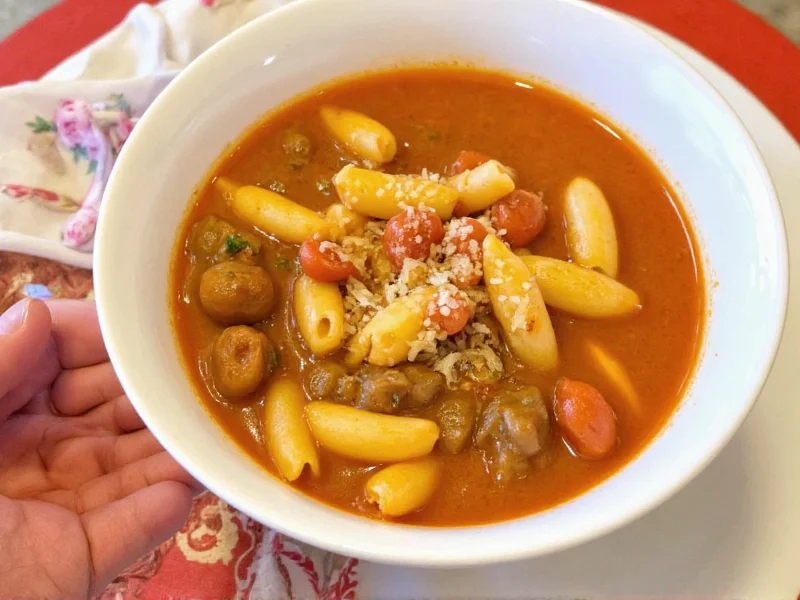The Cultural Roots of Italy's Beloved Bean Soup
Pasta e fagioli represents the essence of Italian cucina povera – resourceful cooking that transforms humble ingredients into deeply satisfying meals. Originating in rural central Italy, particularly in regions like Lazio, Abruzzo, and Molise, this soup sustained farming families through harsh winters using pantry staples. Unlike many Italian dishes with precise recipes, pasta e fagioli varies significantly by household and region, reflecting Italy's diverse culinary landscape while maintaining its core identity as a bean-and-pasta combination.
Essential Ingredients and Their Significance
The magic of authentic pasta e fagioli lies in ingredient quality and technique. Traditional versions use dried rather than canned beans for superior texture and flavor development. Cannellini beans provide creamy richness, while borlotti (cranberry beans) offer earthier notes. Small pasta shapes like ditalini, tubetti, or broken spaghetti work best, absorbing flavors while maintaining structure in the thick broth. Fresh garlic, rosemary, and extra-virgin olive oil form the flavor foundation, with tomatoes adding acidity and depth.
Many Americans recognize Campbell's canned version, but authentic pasta e fagioli contains no meat, distinguishing it from minestrone. The soup's thickness approaches that of a stew – so substantial that Italians often call it "pasta e fasioi in tecc" (pasta and beans in a roof), referring to its spoon-standing consistency.
Regional Variations Across Italy
| Region | Distinctive Features | Key Ingredients |
|---|---|---|
| Rome (Lazio) | Tomato-based, thicker consistency | Cannellini beans, pancetta (optional), tomato passata |
| Abruzzo | "Pasta e fagioli alla ventricina" with spicy sausage | Borlotti beans, ventricina sausage, chili flakes |
| Tuscany | "Fagioli all’uccelletto" style with sage | Cannellini beans, sage, garlic, no tomatoes |
| Southern Italy | Thinner broth, more vegetables | Borlotti beans, celery, carrots, tomatoes |
Perfecting Your Homemade Pasta e Fagioli
Creating authentic pasta e fagioli requires attention to technique. Start by soaking dried beans overnight – this reduces cooking time and improves texture. Sauté garlic and rosemary in olive oil until fragrant but not browned, then add tomatoes and let them cook down for 10 minutes to eliminate raw acidity. Add soaked beans with their cooking liquid (discarding any aromatics like bay leaves), bringing to a gentle simmer.
The critical moment comes when adding pasta. Cook it directly in the soup for 80% of the recommended package time, allowing it to finish cooking in the residual heat after removal from stove. This prevents mushy pasta while letting it absorb flavors. For the traditional thick consistency, mash some beans against the pot wall during the final minutes of cooking. Let the soup rest for 15 minutes before serving – this allows flavors to meld and texture to stabilize.
Modern Adaptations Without Sacrificing Authenticity
While purists insist on dried beans and no meat, thoughtful adaptations maintain the dish's spirit. For vegetarian pasta e fagioli soup that stays true to tradition, enhance umami with kombu seaweed during bean cooking. Vegan versions work beautifully by omitting optional pancetta. Gluten-free adaptations succeed using small rice or corn pasta shapes added at the very end.
Time-pressed cooks can use canned beans with adjustments: rinse thoroughly, use less liquid, and add a splash of the bean canning liquid (aquafaba) for creaminess. Never add pasta to canned bean versions – cook it separately and combine when serving to prevent mushiness. For deeper flavor in quicker preparations, use homemade vegetable stock instead of water when cooking beans.
Serving Traditions and Pairings
Italians traditionally serve pasta e fagioli in wide, shallow bowls with a generous drizzle of high-quality olive oil and freshly grated pecorino romano. The soup should be thick enough that a spoon stands upright. Pair with crusty bread for dipping – preferably pane di Altamura or ciabatta – which soaks up the flavorful broth while adding textural contrast.
For wine pairings, choose medium-bodied reds like Chianti or Montepulciano d'Abruzzo that complement without overwhelming the soup's earthy flavors. Leftovers improve overnight as flavors deepen, though you may need to add broth when reheating as the pasta continues absorbing liquid. Freeze portions for up to three months, though pasta texture degrades slightly upon thawing – fresh pasta added during reheating solves this issue.
Frequently Asked Questions
What does pasta e fagioli literally mean in English?
Pasta e fagioli translates directly to “pasta and beans” in English. The name reflects the soup's two essential components, though regional variations may include additional ingredients like tomatoes, garlic, and herbs.
Is pasta e fagioli traditionally a vegetarian dish?
Yes, authentic pasta e fagioli originates as a vegetarian peasant dish from Italy's cucina povera tradition. While some regional versions include pancetta or sausage, the fundamental recipe uses only beans, pasta, vegetables, and olive oil.
Why is my pasta e fagioli too thin or too thick?
The ideal pasta e fagioli has a thick, stew-like consistency. If too thin, simmer uncovered to reduce liquid or mash some beans to release starches. If too thick, gradually add warm broth or water. Remember that pasta continues absorbing liquid after cooking, so aim for slightly thinner consistency when serving.
Can I make pasta e fagioli without soaking beans overnight?
Yes, but results differ. Quick-soak method (boil 2 minutes, then steep 1 hour) works in a pinch, though traditional overnight soaking yields creamier beans with better texture. Canned beans provide fastest option – use two 15-ounce cans (rinsed) and reduce cooking liquid by 50% for acceptable results.
What’s the best pasta shape for authentic pasta e fagioli?
Small tube pastas like ditalini or tubetti work best as they capture the thick broth. Broken spaghetti or small elbow macaroni serve as acceptable substitutes. Avoid large pasta shapes that overwhelm the beans, and never use long strands like spaghetti which don't distribute evenly in the soup.











 浙公网安备
33010002000092号
浙公网安备
33010002000092号 浙B2-20120091-4
浙B2-20120091-4